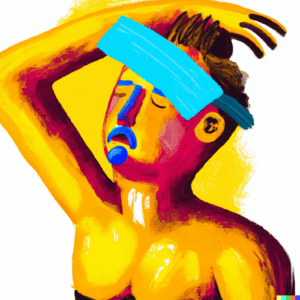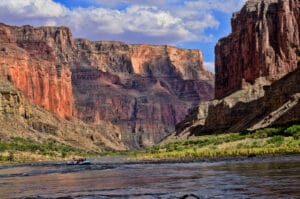During river trips there are variety of problems that can arise from being subjected to, working in, and playing in hot temperatures. These include Heat Cramps, Heat Exhaustion, Heat Syncope, Heat Stroke, and Hyponatremia.
What is Heat Acclimatization?
In simple terms heat acclimatization is what happens when our bodies become used to a hotter climate and are more comfortable being active in hot weather. As this happens we develop the ability to hike longer, work harder, and sleep better at higher temperatures. According to the CDC, heat acclimatization is “the beneficial physiological adaptations that occur during repeated exposure to a hot environment.”
What are the Physiological Changes that occur with Heat Acclimatization?
Physiological adaptations make it easier and safer to work and play in hot environments like the Grand Canyon. One of the key adaptations is the sweating our bodies do to maintain body temperature. As we become more acclimatized to hot environments, humans sweat earlier, more, and with a reduced loss of electrolytes. Other adaptations that occur with heat acclimatization include increased skin blood flow at a given core temperature, a better ability to perform tasks with a lower heart rate and core temperature, and stabilization of the circulatory system.
Why is Heat Acclimatization Important?
In the case of river running and outdoor adventure travel, the more equipped your body is able to deal with the heat, the more enjoyable your trip will be.
Who Can benefit from Heat Acclimatization?
Heat acclimatization can be beneficial for anyone planning to work or play in warm environments.
Grand Canyon
The Grand Canyon is home to the most famous section of the Colorado River. Rafting the Grand Canyon can be a challenge during the shoulder and summer months because of high temperatures.
Data From the Western Regional Climate Center-PHANTOM RANCH, ARIZONA
Period of Record Monthly Climate Summary
Period of Record : 8/ 1/1966 to 12/31/2005
It is interesting to note that this data stops after 2005. The World Meteorological Organization determined that the last 8 years, (2015-2022) are the hottest on record. Doing a little research on my own from 2022 I found out the average high temperature for June 2022 at Phantom Ranch was 104.3 degrees Fahrenheit, and the average high temperature at Phantom Ranch for a two week period from July 9-22, 2022 was an astounding 110.6 degrees Fahrenheit!
| Jan | Feb | Mar | Apr | May | Jun | Jul | Aug | Sep | Oct | Nov | Dec | Annual | |
| Average Max. Temperature (F) | 56.7 | 63.7 | 72.4 | 81.9 | 92.1 | 102.6 | 106.0 | 102.6 | 95.6 | 83.0 | 67.7 | 56.7 | 81.7 |
| Average Min. Temperature (F) | 37.0 | 41.5 | 47.3 | 54.4 | 63.2 | 71.8 | 76.6 | 74.4 | 68.3 | 57.5 | 45.7 | 37.6 | 56.3 |
| Average Total Precipitation (in.) | 1.02 | 0.92 | 0.92 | 0.52 | 0.33 | 0.20 | 0.91 | 1.35 | 0.98 | 0.90 | 0.82 | 0.73 | 9.61 |
| Average Total SnowFall (in.) | 0.2 | 0.0 | 0.0 | 0.0 | 0.0 | 0.0 | 0.0 | 0.0 | 0.0 | 0.0 | 0.0 | 0.1 | 0.3 |
| Average Snow Depth (in.) | 0 | 0 | 0 | 0 | 0 | 0 | 0 | 0 | 0 | 0 | 0 | 0 | 0 |
When doing research about heat acclimatization, two different disciplines dominate the internet. The first is the US military and the second is athletics. Two places with abundant information about heat acclimatization on the web are the Korey Stinger Institute and the US Army.
Korey Stinger Institute
Korey Stinger Institute Website
Korey Stinger was a pro-bowl offensive lineman for the Minnesota Vikings who passed away from exertional heat stroke. His wife Kelci teamed up with exertional heat stroke expert Douglas Casa, Ph. D, ATC at the University of Connecticut. Together they developed an exertional heat stroke prevention institute to honor her husband. The Korey Stringer Institute was started in April 2010. The Korey Stinger Institute is geared toward heat acclimatization in athletes.
According to the Institute, ” When preparing to acclimatize to the heat, athletes should gain a base level of fitness in a cooler environment prior to heat exposure. Fit individuals already have some of the physical advantages that are gained with acclimation—for example, an increased sweat rate.” After these basic levels of fitness are achieved, the next step is to gain gradual heat acclimatization. The Korey Stinger guidelines do this by gradually introducing more heat and exertion to football players. At first players are subject to one practice per day without equipment. By day six they can wear full gear. Practice time is gradually increased over a couple weeks. This gradual acclimatization improves an “athlete’s ability to handle heat stress during exercise.”
Ranger and Airborne School Students-HEAT ACCLIMITAZATION GUIDE(2003)
US Army Heat Illness Prevention Pocket Guide
Although the guide is meant for Ranger and Airborne School Students the information in the guide can benefit anyone. The guide “provides practical guidance to obtain optimal heat acclimatization to both maximize performance and minimize the risk of becoming a heat casualty.” The guide makes the point that acclimatization is specific to a certain climate and level of activity. However being acclimatized to a Desert Environment will greatly help a soldiers ability to work in a Jungle Environment and vice versa. It goes on to say that “Soldiers who perform light or brief physical work will achieve the level of heat acclimatization needed to perform that task,” but “additional acclimatization and improved physical fitness will be needed” to perform a more strenuous task in a hot environment.
According To the Guide The Benefits of Heat Acclimitazation are:
- Thermal Comfort-Improved
- Core Temperature-Reduced Sweating-Earlier & Greater
- Skin Blood Flow-Earlier
- Body Heat Production-Lower
- Heart Rate-Lowered
- Thirst-Improved
- Salt Losses(sweat and urine)-Reduced
- Organ Protection-Improved
Heat Acclimatization-How do you obtain it?
According to the guide you must exercise hard enough to produce an elevated body temperature and cause “perfuse sweating.” This needs to happen repeatedly to acclimatize. For the best results the exercise needs to happen in the hot environment soldiers are working in. It is not always possible to acclimatize under the same environment, and when this is the case work out in a warm room wearing sweatsuits.
How long does it take to become heat acclimatized?
The guide claims “two weeks of daily heat exposure is needed to induce heat acclimatization.” During this time two hours per day need to be allotted to the the acclimatization. This can be broken into two 1-hour sessions. During this time soldiers need to gradually increase intensity each day until meeting “the required physical activity level for the advanced military training and environment.”
How long do the benefits of heat acclimatization last?
According to the Heat Acclimatization guide “The benefits of heat acclimatization will be retained for about 1 week and then decay about 75 % by 3 weeks.”
BE YOUR “BEST“
Always talk to your physician before starting a heat acclimatization exercise program.
Here are some tips for becoming heat acclimatized.
Begin Early-
Start training at least a few weeks before your rafting trip
Environment-
Mimic the environment you are going to. For example: In a warm environment turn off the air conditioner. In a cold environment wear a sweat suit to the gym to workout in.
Sweat-
Work out hard enough and long enough to induce sweating. As you become comfortable add more time and load to the workout.
Teach Yourself To Drink and Eat-
Make sure to drink plenty of water and electrolytes, and eat plenty of food. Make sure to not skip any meals. Meals are required to replace most of your electrolytes and water. One method to determine how much water you lose during exercise is to weigh yourself before and after a work-out. For every pound you lose, you should rehydrate yourself with 16 ounces of fluid.







